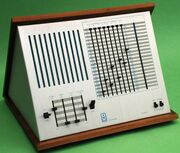
Triadex Muse, courtesy of mmmmaven.com
An algorithmic composition synth designed by two professors from the Massachusetts Institute of Technology, and released by the Triadex company in 1972. The two designers were both people noted in their fields: artificial intelligence research Marvin Minksy, and computer scientist Ed Fredkin. The Muse, and the accessories offered with it, were the only products ever produced by Triadex.
The Muse was packaged in a wedge-shaped tabletop box. The left half of the panel consisted of a set of controls that allowed the user to start, stop, and single-step the sequences produced by the device, a set of slider controls that allowed the user to vary the tempo and base frequency, and a small built-in loudspeaker. The right half was dominated by eight 40-position slide switches, which set up parameters for controlling the sequence generator. To keep it simple, the generator consisted of discrete digital circuitry (no microprocessor; none were widely available at the time) which produced pseudo-random number sequences, which the circuitry massaged so that the numbers were mapped to a diatonic scale over a range of one octave. The resulting digital value went into a D/A converter which produced a control voltage to drive a VCO. A LFO served as a clock to drive the number generator and determine note intervals (a given note had a duration of an integer number of clock cycles).
Moving the slide switches changed the parameters of the number generator to change the sequence. Sequences could range from very short (two notes) to practically infinite. Since the number was pseudo-random in nature, restarting the generator from an initial state with a given set of switch settings would always produce the same sequence. A start switch allowed any sequence to be restarted from the beginning. Triadex provided patch sheets that allowed the user to record settings that produce desirable results. The actual sound circuitry was very basic. The VCO only produced a square wave, and there was almost no tonal control.
Triadex actually advertised the Muse as an alternative to a radio for casual listening; in theory, the user could set up a desired sequence and simply let it run, enjoying the results. In reality, the unvarying timbre and limited range of the scale probably made it tiring to listen to after a few minutes. Triadex offered several accessories, including an interface box that allowed a second Muse to be slaved, to produce harmonies. The Muse sold poorly; most historians estimate that less than 300 were built. However, it is now regarded as groundbreaking in the area of algorithmic composition, as well as an interesting chapter in the careers of Minsky and Fredkin.